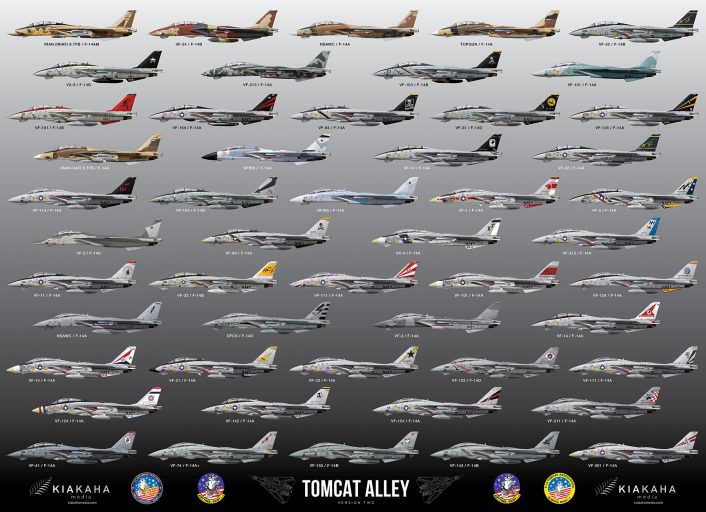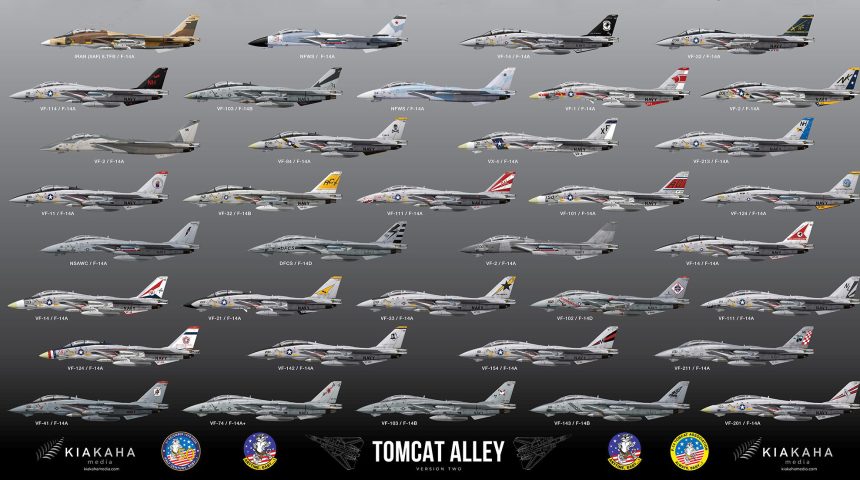50 years after it flew for the first time (and 15 years after it was retired by the U.S. Navy), the F-14 Tomcat remains one of the most loved fighters ever. Here are its 100 most iconic liveries.
The world of aircraft enthusiasts has recently celebrated the 50th anniversary since the first flight of the legendary F-14 Tomcat. The first Full Scale Development (FSD) Grumman F-14A Tomcat took off for its maiden flight from Grumman’s flight test centre at Calverton, on Long Island, on Dec. 21, 1970.
Throughout its career with the U.S. Navy, that officially retired the type on on Sept. 22, 2006, during a ceremony held at NAS (Naval Air Station) Oceana, (although the last flight of a Tomcat in Navy service took place a few days later, on Oct. 4, 2006), the “Turkey” (as the aircraft would later be nicknamed) sported a myriad of paint schemes: from the flamboyant ones of the early age, to the overall grey/low-visibility ones of the last years. Among them many special liveries, including those applied to the Tomcats used in the adversary role at the Naval Strike and Air Warfare Center and the striking ones of the CAG birds.
While the Navy has retired the type 15 years ago, the Iranian Air Force, the only other Tomcat operator, continues to fly the type. Tehran initially ordered 80 F-14s, with 79 being delivered beginning in February 1976. According to different sources, Iran still operates around 40 airframes, some of those upgraded to F-14AM (“Modernized”) standard that includes domestic avionics (radar and RWR) and weapons: R-73E, AIM-54A, AIM-7E and AIM-9J. IRIAF has two types of F-14As: PMC (Partially Mission-Capable) ones, usually suitable for Training and can become FMC in case of war; and Fully Mission-Capable Tomcats with fully operable fire control system, armament system and INS. These FMC F-14As are usually used for 24/7 Quick Reaction Alert and other combat missions (Usually 70% of the airworthy Tomcats are FMC). Around 24 aircraft are estimated to be fully ready for combat, with partial readiness maintained for 16 more airframes. These aircraft are based at TFB.8 (Tactical Fighter Base 8) Baba’i near Eshahan, in central Iran.
Livery-wise, the Persian Tomcats are quite interesting: some are painted in a light blue and grey color scheme, while others were given a three-tone Asian Minor II camouflage pattern, loosely resembling the “splintered” one adopted by Russian 4th and 5th generation fighter planes and U.S. Aggressors.
To celebrate the F-14 and the variety of paint schemes it carried with all the units it operated under throughout its history, Ned Dawson’s Kiakaha Media in cooperation with The F-14 Tomcat Association designed two pretty interesting posters each featuring 50 Tomcat profiles by our friend Ugo Crisponi of Aviationgraphic.com. Needless to say, the posters don’t include ALL the color schemes worn by the Tomcats in 50 years (it would be impossible), but 100 of the most iconic ones with at least one from each of the frontline and experimental units which operated (or still operate, in Iran) the aircraft.
Here’s the first one (already sold out):

Here’s the second version, that can be ordered here only until Apr. 10, 2021):










